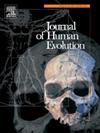cataloniates (Pliobates)尺骨形态(Pliobates coidea: crouzelidae): carrine运动多样性和前肢进化的见解
IF 3.1
1区 地球科学
Q1 ANTHROPOLOGY
引用次数: 0
摘要
cataloniae Pliobates是一种小体crouzeliid pliopithecoid,来自Abocador de Can Mata (ACM)中新世(~ 11.6 Ma);伊比利亚半岛东北部的vall本文章由计算机程序翻译,如有差异,请以英文原文为准。
Ulnar morphology of Pliobates cataloniae (Pliopithecoidea: Crouzeliidae): Insights into catarrhine locomotor diversity and forelimb evolution
Pliobates cataloniae is a small-bodied crouzeliid pliopithecoid from the Miocene (∼11.6 Ma) of Abocador de Can Mata (ACM; Vallès-Penedès Basin, NE Iberian Peninsula). It exhibits a mosaic of primitive (stem catarrhine) and derived (modern hominoid-like) postcranial features. The holotype partial skeleton, from locality ACM/C8-A4, includes an almost complete ulna—a bone that plays a critical role in forearm flexion-extension and pronation-supination. Here, we use landmark-based three-dimensional geometric morphometrics to evaluate the closest morphometric affinities of the Pliobates ulna and explore its implications for the locomotor repertoire of this taxon. The comparative sample includes 156 specimens corresponding to 35 species from 20 anthropoid genera, three lorisid genera, and 10 fossil catarrhines. Our results indicate that the trochlear notch morphology of Pliobates resembles that of stem catarrhines and other nonhominoid primates. However, Pliobates differs from cercopithecoids (especially terrestrial taxa) in radial notch features related to enhanced pronation-supination capabilities, closely resembling the condition displayed by crown hominoids, Ateles, and Loris. In turn, the distal ulna of Pliobates does not overlap with any extant group and differs from the other fossils analyzed, most closely resembling that of hylobatids and lorisids. Pliobates probably had an extensive range of movement in the distal forearm, as indicated by the incipiently expanded semilunar ulnar head, the relatively short styloid process, the deep fovea, and the hooklike styloid process. This suggests that Pliobates would have frequently displayed nonstereotypical limb postures and slow locomotor behaviors. Overall, the ulnar morphology of Pliobates suggests that its locomotor repertoire may have combined cautious above-branch quadrupedalism and eclectic climbing with nonagile suspensory behaviors resembling those of Ateles.
求助全文
通过发布文献求助,成功后即可免费获取论文全文。
去求助
来源期刊

Journal of Human Evolution
生物-进化生物学
CiteScore
6.30
自引率
15.60%
发文量
104
审稿时长
3 months
期刊介绍:
The Journal of Human Evolution concentrates on publishing the highest quality papers covering all aspects of human evolution. The central focus is aimed jointly at paleoanthropological work, covering human and primate fossils, and at comparative studies of living species, including both morphological and molecular evidence. These include descriptions of new discoveries, interpretative analyses of new and previously described material, and assessments of the phylogeny and paleobiology of primate species. Submissions should address issues and questions of broad interest in paleoanthropology.
 求助内容:
求助内容: 应助结果提醒方式:
应助结果提醒方式:


